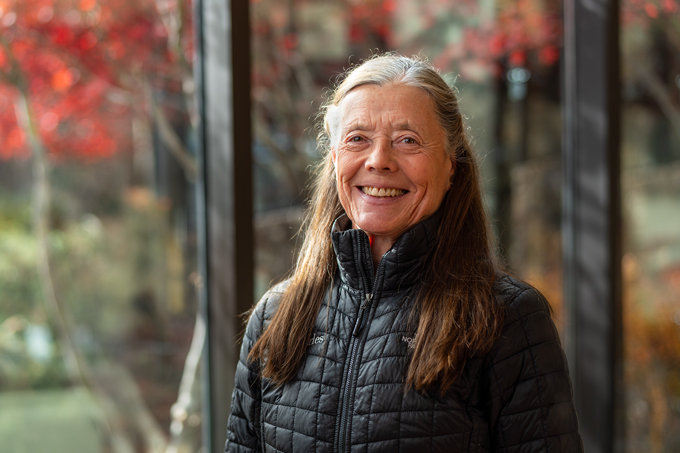A simple change in practice is making a big difference at St. Charles, both financially and environmentally.
The change can be traced back to St. Charles’ partner for anesthesia care, the Bend Anesthesiology Group (BAG), where last year, a handful of providers formed a committee charged with improving the practice’s environmental stewardship and sustainability.
Dr. Holly Graham is a member of that committee. She said the group is interested in exploring ways to increase energy efficiency and to reduce the volume of plastics used by BAG providers during their procedures. But in the world of anesthesiology, there is one particular piece of “low-hanging fruit,” she said, when it comes to improving sustainability: Reducing the use of anesthetic gases such as desflurane.
“Studies show that desflurane is horrendous for the environment, and there are things we can do to change that,” Graham said. “There’s so much evidence behind it that we felt like this would be a good place to start as far as trying to make a difference.”
Desflurane is one of two gases most commonly used as a general anesthetic for human beings. The other is called sevoflurane. Both are inhaled by patients, who only metabolize less than 5% of the gas. The rest is exhaled into the operating room, where a ventilation system sucks it in and then pumps it out of the hospital through the roof.
The problem is that inhaled anesthetics are potent greenhouse gases. Up to 5% of all health system-related greenhouse gas emissions – and 50% of emissions from surgical services – have been attributed to inhaled anesthetic pollution.
“The intersection of health care and environmental sustainability is a very up-and-coming topic,” Graham said. “It’s becoming very important and it’s not going away.”
According to a study, desflurane stays in the atmosphere for 10 years, compared with 1.2 years for sevoflurane. Authors of that study also calculated that desflurane has about 26 times the global warming potential of sevoflurane.
In recent years, many providers at BAG have preferentially used desflurane, Graham said. Given the environmental detriment of the gas, she and the environmental committee targeted the issue as a potential place to affect positive change.
At about the same time, Debra Carlson, who oversees pharmaceutical purchasing for St. Charles, was looking to move the health system to a different provider of anesthesia gas. Her primary goal was to reduce costs, though she knew switching from desflurane to sevoflurane would be much better for the environment.
“I brought it up as an opportunity to change who we hold the contract with, and that’s how we started talking about our inhaled gas usage,” Carlson said. “From there, it came together pretty easily. The (BAG) providers are the ones who wanted to take on a trial.”
Graham and the environmental committee presented the information about desflurane to their colleagues and asked them to spend the month of May 2021 either limiting or completely eliminating the use of the gas. Then, they could compare the carbon emissions for the month to May of 2019 to see exactly how much difference the move would make.
“What we found is that we were able to decrease our carbon emissions for all cases by about 54%. It was pretty shocking to see,” Graham said. “The biggest thing was just educating my colleagues. Once everyone understood the implications of using desflurane, they started making that change on their own.”
In fact, Graham found that some BAG providers had made the switch a few years ago, after NPR published a story about a Portland anesthesiologist who’d led a similar effort at his practice. One of the BAG providers, Dr. Erin Zurflu, called switching from desflurane to sevoflurane “a no-brainer” for a number of reasons.
“I made the switch the day I read that article. I haven’t used desflurane again, and I haven’t missed it. I found a reasonable and safe alternative and I think my patients are happy with it,” Zurflu said.
“And when it came time to educate the other providers about this,” she continued, “we showed them the data about the environmental impact, and we also said, ‘You know, this will save (St. Charles) a lot of money, because desflurane is quite a bit more expensive. Why don’t we do it proactively and show them that we care about the environment and that we’re good partners at the same time?’”
As a result of the change, St. Charles has so far saved more than $90,000 just in the cost of gas, Carlson said. The health system will also save money by reducing from 22 to six the number of vaporizers needed to administer desflurane. Those vaporizers cost about $90,000 per year to rent, Carlson said.
In a typical year with normal surgical volumes, changing out the machines would have been difficult. But thanks to COVID-19, surgical volumes were lower than usual, which gave St. Charles a chance to make the move, Carlson said.
“We were coming to the end of our contract, we saw a window of opportunity and we said, ‘Let’s just do it,’” Carlson said. “We caught this at the right time.”
To be clear, desflurane is still available for use at St. Charles, in part because some providers believe it is preferable for some patients, Graham said. But it’s available in a much more limited capacity, and BAG providers are committed to only using it when absolutely necessary, she said.
“This is a passion that I have, to want to make a difference in the world that we’re leaving for future generations,” she said. “This is one place where we could do that, and I’m just so pleased that my colleagues have rallied behind this. Once they saw it was a problem, they stepped up and it feels good that we’re making a difference.”





